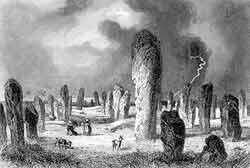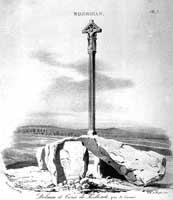- Home
- Discover the megaliths of Morbihan
- Reality and fantasy
- Traditional legends and modern myths
Myths and legends are always difficult to interpret, especially where megaliths are concerned, since they combine:
- remnants of authentic ancient tradition,
- 'recurrent myths', regularly repeated but not necessarily connected with ancient lore,
- ‘erudite myths’, inspired by ideas which were popular at a certain time among the learned, became artificially associated with a site and were eventually incorporated into the folk tradition.
These myths tended to appear mainly at certain specific periods:
- the late 16th century, under the influence of the Council of Trent and the Catholic Church's 'missionary' policy, when the myths had biblical or evangelical connotations,
- the 18th century and the ‘Enlightenment’, when they referred to Classical Antiquity,
- the early 19th century, with the rise of Romanticism and Celtomania,
- the late 19th century and the resurgence of 'Arthurian' legends
- the present day with its various ‘scientific myths’.
In the 19th century, illustrators deliberately made use of the fantastic.
Traditional beliefs associated with Morbihan megalithic culture
Dwarves of all shapes and sizes are often involved in the building and/or the visiting of megalithic tombs: Mané-Kerioned (the Dwarves’Mount), Ty-Korriganed (the Dwarves’house), etc. Contrary to many other regions, giants are almost never mentioned in Morbihan.
According to the legend, fairies piled up the Mané-er-Hoeg stones at Locmariaquer to help a poor widow guide her returning son to safety. The use made of the monument in this legend can be compared to the its use as a landmark reported by Garcie Ferrande, or to the beacon described by Boureau-Deslandes.
The shapes of the block in the foreground were emphasized so as to resemble a toad, which was how the megaliths were sometimes traditionally described.
Traditional beliefs related to fertility:
- Infertile women would rub against fertility stones, like the Grand-Menhir of Locmariaquer, the 'vessel', a large block lying at the head of the Menec alignments, and the Cruz-Moquen dolmen at Carnac (adorned with a cross to put an end to such practices).
- In the 18th century, Boureau-Deslandes wrote that megaliths were supposed to watch over flocks and fend off disease. Saint Cornely was later given this role.
- Megaliths have also been compared to plants having grown from seeds sown in regular furrows.
The christianized dolmen of Cruz-Moquen at Carnac.
Divine curse
The main myth is embodied by Saint-Cornely. According to the legend, he turned the Roman legionnaires trying to capture him to stone. The Carnac alignments are supposed to be the main body of troops, while Kerzerho (Erdeven) was the vanguard. Two stragglers can be found at Luffang (Crac'h) and a handful of deserters at Resto (Languidic).
In Saint-Pierre-Quiberon, Saint Helen was supposed to have played the same trick on the Roman soldiers. In other parts of Brittany, the stones stand for blasphemers punished for their misdeeds: merry-makers who showed disrespect to a priest wearing a viaticum (Brasparts, Finistère) or young women who preferred to go dancing on the heath instead of attending Vespers (Langon, Ille-et-Vilaine).


